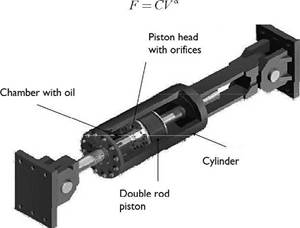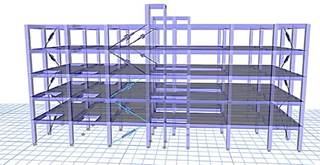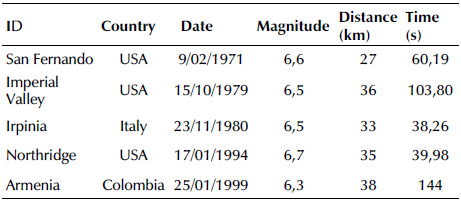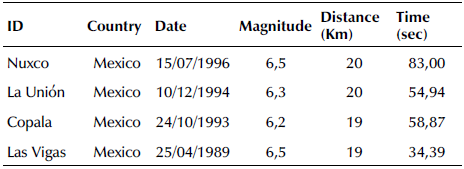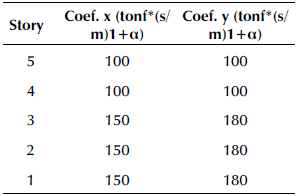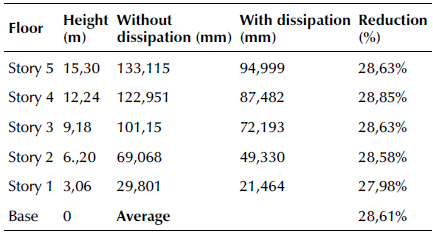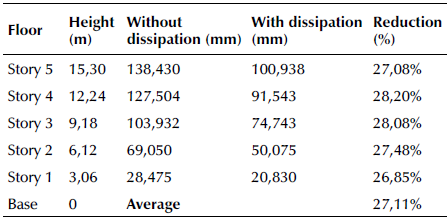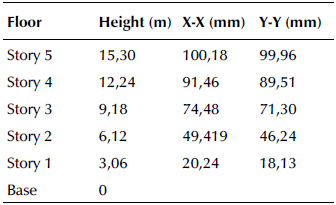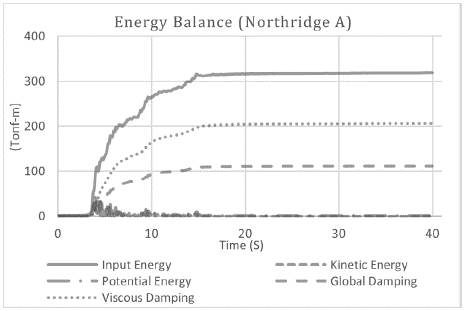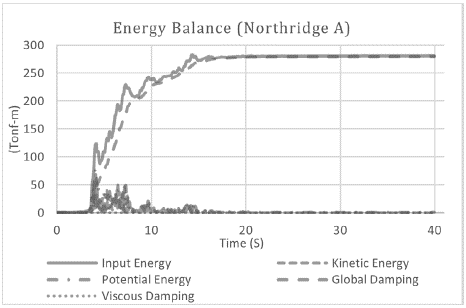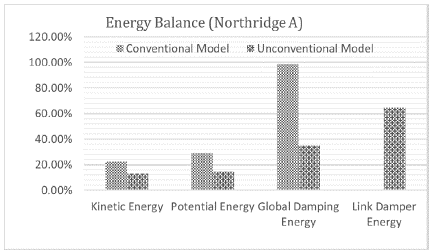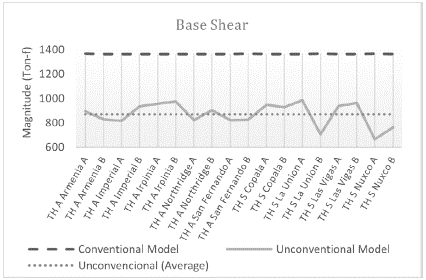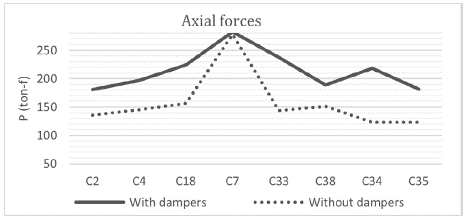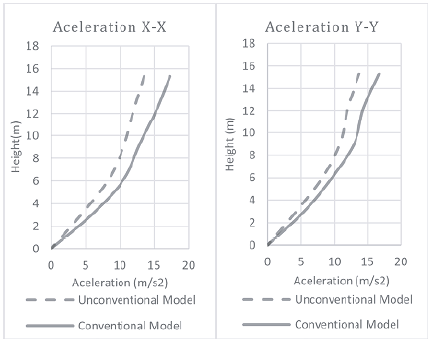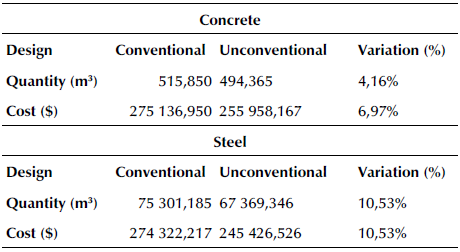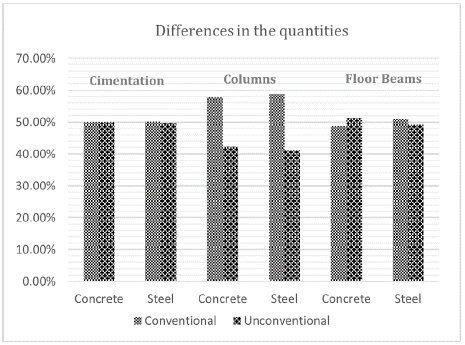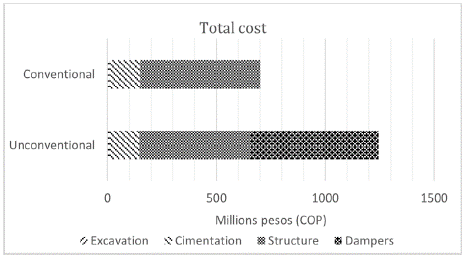Introduction
In the search of solutions to the threat posed by earthquakes, alternative design methods such as energy dissipation systems have been developed, which implement viscous-fluid devices (Enriquez et al., 2020; Hanson, 1993). These devices seek to improve the response of structures to severe earthquakes by incorporating damping and reducing angular distortions, seismic shear, pseudo-acceleration spectrum, and the steel area (Cano-Lagos and Zumaeta-Escobedo, 2012).
When designing buildings, structural engineers always seek to ensure excellent rigidity, resistance, and ductility, aiming to obtain acceptable failure mechanisms in the engineering design. However, since the priority is to save people's lives, elements of the structure can fail, to the point that the building becomes uninhabitable, as long as the structure itself does not collapse. Thus, plastic deformation energy (ESD) plays a vital role in energy dissipation (Rochel Awad, 2012). Conversely, seismic control systems take advantage of the other terms in the energy balance equation (1), such as the mass kinetic energy (Ek), the inherent damping energy of the structure (ED), and the elastic deformation energy (ESS). These are usually quantified in an additional term (damping energy due to supplementary devices, EH) (Oviedo and Duque, 2006). This, in order for the structure not to require plastic hinges to dissipate the input energy (El).
In particular, energy damping systems are highly recommended because they take part in passive control systems, which do not require regular maintenance or an activation system. Moreover, viscous-type energy dampers have many benefits, such as simple installation, high resistance, versatility, longevity, and manageable design. Part of that versatility lets designers use these devices in different structures (León-Joya, 2016; Zhou et al., 2020), reinforce old buildings (Hesam et al., 2017), combine them with other control seismic systems (Zhen et al., 2020), or even protect adjacent buildings (Bhaskararao and Jangid, 2007; Patel and Jangid, 2013). Additionally, this control system is one of the most studied mechanisms to protect buildings, with many positive results (Li and Huo, 2010).
Viscous-type energy dissipation devices are elements that transfer highly viscous fluids from one compartment to another through small orifices, taking advantage of the energy loss generated by the fluid during each oscillation of the structure. Because the dissipator behaves according to the laws of fluid mechanics, the value of the resistive force (F) varies with respect to the translational speed of the dissipator (V). Nevertheless, the parameters C (Damping constant) and a (Velocity coefficient) are used to define the dampers in the structure:
Hence the philosophy of this project, whose objective is to compare the performance of two models of the same building. The first model was built using the parameters of the Colombian Construction Regulation (NSR-10), following a traditional design based on the combination of resistance, durability, deformability, and energy absorption through damage. The second model used viscous-type energy dissipation devices, which increase energy absorption and reduce damage (Colunga-Tena and Gama-Contreras, 2017). This, in order to observe the effectiveness of these design mechanisms in a practical environment from an economic perspective.
Methodology
To carry out this study, the aforementioned structures were exposed to a time-history analysis using representative earthquakes for the area under study. The design and analysis of the structures were performed with the help of the academic versions of the Etabs V18.1 and Safe V16.0.2 software. This made it possible to compare the structural behavior of the two alternatives and, through a budget analysis, to carry out a cost-benefit comparison.
A building for residential use was used in the evaluation. It has a normal occupancy (use group I, NSR-10), consisting of five floors, an elevator, and a staircase, with a height of approximately 15,2 m. The structure is based on moment-resisting frames, a gabled roof, composite slabs in metaldeck, and cementation using combined footings and a foundation slab. The building is located on D-type quality soil. On the other hand, the unconventional building has the same components and two viscous dampers for each direction in every story with a diagonal bracing scheme, as shown in Figure 2.
According to the General Study of Seismic Threats of Colombia carried out by the Colombian Association of Seismic Engineering (AIS), there are two dominant seismogenic sources in the study area: active and subduction. In this sense, the seismic records listed in Tables 1 and 2 were based on a study of the micro seismic zoning of Popayán, which was conducted by Universidad de Los Andes (AIS et al., 2010). These records were obtained from the Pacific Earthquake Engineering Research database, the Colombian Seismic Network, and the National Geological Survey of Mexico.
Based on these seismic records, an elastic review of the two structures was carried out, where the adequate dynamic behavior was verified, with fundamental translational modal shapes and other requirements of Colombian regulation. Next, the structures were designed, assigning the steel required by either the regulation or the analysis in each structural element, which was conditioned by the design spectrum in each case.
In particular, the design of viscous dampers was established by calculating the maximum capacity force required by the device, determined by means of the equation of the dissipator (2) and the damping coefficient C, which was obtained from the objective viscous damping (βvis) (Fuentes-Sadowski, 2019; Genatios and Lafuente, 2016). The starter viscous damping ratio was determined via Equation (3) in order to estimate a value according to the relation between the objective drift (δObj, NSR-10) and the maximum drift (δMax) of the building analyzed without dampers. Here, the inherent damping (β0) was taken as 5%.
Next, a damping constant was determined with the properties of the dampers, the structure, and its modal response in a nonlinear analysis (Dall'Asta et al., 2016). The parameters cpK cprj, A, and w are the vibration mode, the relative displacement, the amplitude, and the frequency, respectively, of the fundamental time period of the structure. 9j is the inclination angle of the dissipator, mi is the floor mass, and Л are values that depend on the gamma function and the velocity coefficient a (NEHRP, 2020).
As the seismic response in each direction of the structure differs, the damping constant is calculated independently, given that the direction of the structure that is flexible requires greater damping than the other one, which has less flexibility. This means that greater resistive forces are needed. When the output force from the dampers is limited, the structural members and connections are more economical. As a result, the damping constants for the structure under analysis were determined through several iterations whose aim was always to obtain the best behavior and the lowest cost for the devices.
The most efficient placement of dampers will be in the perimeter of the structure, aiming to control any torsional motion of the building with respect to its center of mass in its fundamental shape modals. Moreover, for low-rise buildings, dampers are typically placed at all floor levels to capture and absorb the energy at its source throughout the structure (Taylor Devices Inc., 2022; Díaz, 2014). It is important to note that the metallic elements that transfer the earthquake force to the devices had to be designed with a safety factor of 1,5.
The expected viscous damping ratios (βvis) are usually different from the starter ones because the placement is not considered in the estimation. The damping constant was modified in order to obtain the best results. In this framework, the viscous damping ratios were 10,7% in the X-direction and 8,4% in the Y-direction.
Finally, the amount of material required and the construction costs of each of the alternatives were calculated, and a budget analysis considering only the structural elements was carried out to fulfil the aim of the research.
Result analysis
In order to characterize the results and define the most favorable alternative, the following parameters were evaluated: displacements, energy balance, basal shear, accelerations, element design, and construction costs. These parameters showed the most significant differences among the two alternatives.
Displacements
The first significant change that could be observed in the designs was a reduction in displacements. In the unconventional model, these were reduced by 28,61% in the X-direction and 27,11% in the Y-direction, i.e., with respect to the structure without dampers (Arlinton, 2020; Marko, et al., 2004). Depending on the design, a reduction of up to 80% can be achieved (Sajjan and Biradar, 2018). This allowed the project to comply with regulations without the need for additional modifications. These results are shown in Tables 4 and 5.
As for the traditionally designed building, much larger cross-sections were required, as well as two additional columns, in order to increase the rigidity of the building and thus guarantee the maximum displacement allowed by the regulations. The results for this case are presented in Table 6.
Based on the above, the two structures were compared, whose displacements were similar in order to comply with the regulations. However, it should be noted that the dimensions and properties of the structural element sections in the two structures are different: they are greater in the conventional model.
Energy balance
The reduction in the non-traditional model's displacements was mainly produced by the redistribution of the earthquake's energy in the structure. The damping devices take up to 64,63% of the input energy, while the overall damping of the structure only takes 34,84%, leading to reductions in the stresses on the structure and in the damage to structural elements.
On the other hand, in the conventional model, the energy of the incoming earthquake is dissipated through the inherent damping of the structure, which is determined by the energy dissipation capacity of the materials. Thus, the building can enter the inelastic range, generating plastic hinges and damages to structural and non-structural elements, which means increased reparation costs to rehabilitate the building.
Figure 5 presents the comparison of the maximum energy values, where the great difference in the energy distribution of the two studied models can be observed. In particular, the energy of the earthquake taken by the global damping of the structure is reduced from 98,69 to 34,84%, reducing 63,85% of the earthquake's energy, a value close to the energy assumed by the viscous damping (64,63%) in the non-traditional model. Moreover, the kinetic and potential energy were reduced, thus improving behavior in the first moments of an earthquake.
Stresses
The concept of basal shear is used to quantify and show the difference in terms of stresses between the two models as a response of the structure against ground motion. Thus, this difference shows the reduction of the structural elements in seismic demand. Figure 6 compares the shear stresses of the models under study. The model with dissipators reduced an average 36,21% of the stresses present in the conventional structure, which leads to a lower demand on the structural elements in the design.
At the same time, the inclusion of dissipators increased the axial forces in the columns adjacent to the devices, which implies that their capacity must be improved (Figure 7) (Guevara-Huatuco and Arias-Torres, 2012). However, it is noteworthy that the increase in the capacity of these columns did not exceed what was required in the conventional model.
Accelerations
Additionally, the acceleration of each floor and model was determined in order to observe the reduction in the output accelerations of the earthquakes. There was indeed an average decrease of 21,21%, which confirms the redistribution of energy, where the kinetic energy of the mass had less participation and consequently less force on the oscillations of the structure.
In particular, the structure presented a reduction of 21,63% in the X-direction and of 17,46% in the Y-direction. The latter was slightly lower because, in this direction, the structure is more flexible and less redundant, with just four columns against the eight columns in the other direction.
Design and budget
Finally, the variation in the quantities of concrete and steel for the construction of each design model was determined. Since the implementation of dampers causes a reduction in the cross-sections, the characteristics of the materials and the spectrum of pseudo-accelerations of the unconventional design led to a quantity reduction, and therefore to a cost reduction of 6,97% for concrete and 10,53% for steel (Table 7).
It should be noted that the reduction with respect to the amounts of steel and concrete in the unconventional design takes place differently depending on the structural element, namely cementation, columns, and floor beams. Figure 9 shows that columns benefit the most from the implementation of viscous fluid dampers, as these allow for the greatest reduction of concrete and steel, whereas the difference is not as large in the foundations and floor beams.
As for the total construction costs of each building, the conventional model would be valued at $700 639 558 COP, while the unconventional design would have a cost of $ 1 245 065 084 COP, approximately 77,7% higher than the former. However, considering the finishing costs of the building and the repairs made to a structure in the event of an earthquake, the extra cost of the dissipators can be justified (Benavides-Ortiz, 2015).
According to the background of this research, the rate of increase in the construction costs of a model with viscous dampers under similar conditions is 1,7 with respect to the conventional model, which is close to the value obtained. In addition, to equalize the investment costs, the building should be higher than 18 stories, considering that this value varies depending on the level of importance, type of soil, and area of seismic threat (Benavides-Ortiz, 2015)
Conclusions
According to the information collected through this study, the following remarks can be made:
For the design with viscous fluid dissipators, one of the most important considerations to take into account is the determination of the energy dissipation coefficient C, as values between 100- and 300-tons force ■ (s / m)1+α are recommended so that the devices are not oversized, expensive, or wasteful.
As a result of the time-history analysis of the unconventional model, the structure exhibits displacement reductions of 28,61 and 27,11%, as well as reducing 21,21% of the floor accelerations and 64,63% of an incoming earthquake's energy, which leads to better structural behavior and greater safety during earthquakes.
Depending on the results, a decrease in the rigidity demand of the structure is noted, due to the fact that the devices absorb a large amount of the input seismic energy. This allows thinner sections to have better behavior and meets the required maximum parameter of angular distortion (Oviedo, 2012).
The building with viscous-type energy dissipators has a better structural performance, since there are less displacements and stresses, thus causing a reduction in sections and materials. While the conventional structure is the most economical construction option, the structural elements of the building were placed under greater stresses.
Despite the many benefits entailed by the implementation of viscous dampers, the process can be very expensive and unfeasible in some cases. However, it should be noted that the use of these devices can be justified in more flexible or more important buildings (Cevasco-Beramendi and Condo Vargas, 2020).
Building structures designed with energy dissipators are an option that should be given greater consideration, as the benefits transcend structural health and human safety. In rare earthquakes, important structures must have a structural performance that is difficult to achieve with conventional designs.
Although the implementation of viscous dampers has an additional cost, the structure requires fewer repairs because it minimizes its incursion into the inelastic range, thus reducing costs and times associated to the possible suspension of service in the building.
The lack of knowledge about the feasibility of using control systems in Colombia was made evident, so research in this area becomes extremely important.















